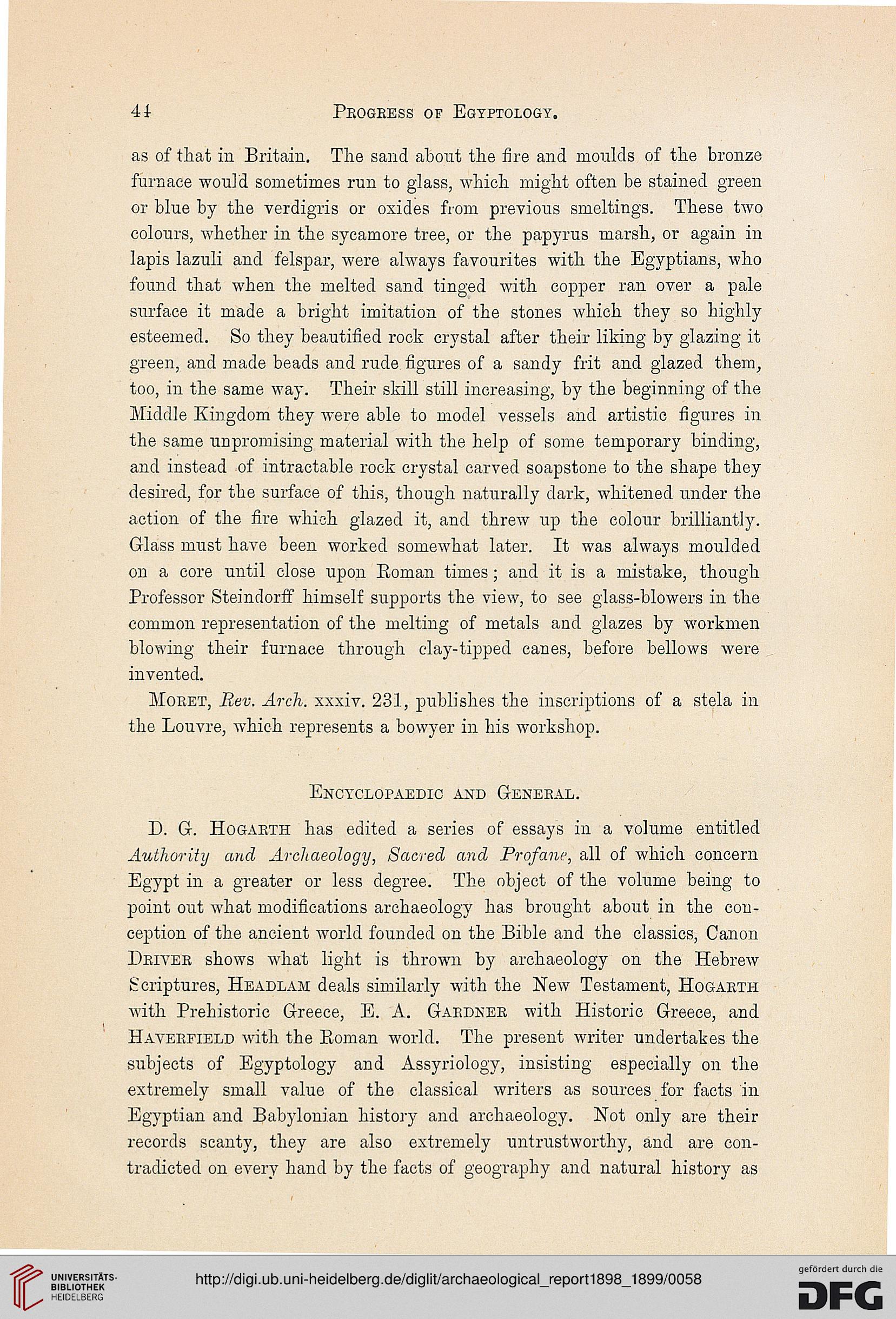41
Progress of Egyptology.
as of that in Britain. The sand about the fire and moulds of the bronze
furnace would sometimes run to glass, which might often be stained green
or blue by the verdigris or oxides from previous smeltings. These two
colours, whether in the sycamore tree, or the papyrus marsh, or again in
lapis lazuli and felspar, were always favourites with the Egyptians, who
found that when the melted sand tinged with copper ran over a pale
surface it made a bright imitation of the stones which they so highly
esteemed. So they beautified rock crystal after their liking by glazing it
green, and made beads and rude figures of a sandy frit and glazed them,
too, in the same way. Their skill still increasing, by the beginning of the
Middle Kingdom they were able to model vessels and artistic figures in
the same unpromising material with the help of some temporary binding,
and instead of intractable rock crystal carved soapstone to the shape they
desired, for the surface of this, though naturally dark, whitened under the
action of the fire which glazed it, and threw up the colour brilliantly.
Glass must have been worked somewhat later. It was always moulded
on a core until close upon Roman times; and it is a mistake, though
Professor Steindorff himself supports the view, to see glass-blowers in the
common representation of the melting of metals and glazes by workmen
blowing their furnace through clay-tipped canes, before bellows were
invented.
Moret, Rev. Arch, xxxiv. 231, publishes the inscriptions of a stela in
the Louvre, which represents a bowyer in his workshop.
Encyclopaedic and General.
D. G. Hogarth has edited a series of essays in a volume entitled
Authority and Archaeology, Sacred and Profane, all of which concern
Egypt in a greater or less degree. The object of the volume being to
point out what modifications archaeology has brought about in the con-
ception of the ancient world founded on the Bible and the classics, Canon
Driver shows what light is thrown by archaeology on the Hebrew
Scriptures, Headlam deals similarly with the New Testament, Hogarth
with Prehistoric Greece, E. A. Gardner with Historic Greece, and
Haterfield with the Roman world. The present writer undertakes the
subjects of Egyptology and Assyriology, insisting especially on the
extremely small value of the classical writers as sources for facts in
Egyptian and Babylonian history and archaeology. Not only are then-
records scanty, they are also extremely untrustworthy, and are con-
tradicted on every hand by the facts of geography and natural history as
Progress of Egyptology.
as of that in Britain. The sand about the fire and moulds of the bronze
furnace would sometimes run to glass, which might often be stained green
or blue by the verdigris or oxides from previous smeltings. These two
colours, whether in the sycamore tree, or the papyrus marsh, or again in
lapis lazuli and felspar, were always favourites with the Egyptians, who
found that when the melted sand tinged with copper ran over a pale
surface it made a bright imitation of the stones which they so highly
esteemed. So they beautified rock crystal after their liking by glazing it
green, and made beads and rude figures of a sandy frit and glazed them,
too, in the same way. Their skill still increasing, by the beginning of the
Middle Kingdom they were able to model vessels and artistic figures in
the same unpromising material with the help of some temporary binding,
and instead of intractable rock crystal carved soapstone to the shape they
desired, for the surface of this, though naturally dark, whitened under the
action of the fire which glazed it, and threw up the colour brilliantly.
Glass must have been worked somewhat later. It was always moulded
on a core until close upon Roman times; and it is a mistake, though
Professor Steindorff himself supports the view, to see glass-blowers in the
common representation of the melting of metals and glazes by workmen
blowing their furnace through clay-tipped canes, before bellows were
invented.
Moret, Rev. Arch, xxxiv. 231, publishes the inscriptions of a stela in
the Louvre, which represents a bowyer in his workshop.
Encyclopaedic and General.
D. G. Hogarth has edited a series of essays in a volume entitled
Authority and Archaeology, Sacred and Profane, all of which concern
Egypt in a greater or less degree. The object of the volume being to
point out what modifications archaeology has brought about in the con-
ception of the ancient world founded on the Bible and the classics, Canon
Driver shows what light is thrown by archaeology on the Hebrew
Scriptures, Headlam deals similarly with the New Testament, Hogarth
with Prehistoric Greece, E. A. Gardner with Historic Greece, and
Haterfield with the Roman world. The present writer undertakes the
subjects of Egyptology and Assyriology, insisting especially on the
extremely small value of the classical writers as sources for facts in
Egyptian and Babylonian history and archaeology. Not only are then-
records scanty, they are also extremely untrustworthy, and are con-
tradicted on every hand by the facts of geography and natural history as




